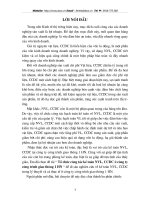Thiết kế và lập trình hệ thống - Chương2
Bạn đang xem bản rút gọn của tài liệu. Xem và tải ngay bản đầy đủ của tài liệu tại đây (169.56 KB, 12 trang )
Systems Design and Programming Micro. Arch. I CMPE 310
1 (Feb. 2, 2002)
UMBC
U M B C
U
N
I
V
E
R
S
I
T
Y
O
F
M
A
R
Y
L
A
N
D
B
A
L
T
I
M
O
R
E
C
O
U
N
T
Y
1
9
6
6
Basic Architecture
Outline:
• Internal programmer visible architecture, e.g. registers
• Real Mode Addressing:
Real Mode Memory: 00000H-FFFFFH (the first 1MB of main memory).
• Protected Mode Addressing:
All of memory (applicable to 80286 and later processors).
Programmer invisible registers to control and operate the protected memory
system.
• 80x86 Memory Paging.
Systems Design and Programming Micro. Arch. I CMPE 310
2 (Feb. 2, 2002)
UMBC
U M B C
U
N
I
V
E
R
S
I
T
Y
O
F
M
A
R
Y
L
A
N
D
B
A
L
T
I
M
O
R
E
C
O
U
N
T
Y
1
9
6
6
Programmer Visible Architecture
Programmer visible registers:
EAX
EBX
ECX
EDX
ESP
EBP
EDI
ESI
AH
AL
BH
BL
CH
CL
DH
DL
AX
BX
CX
DX
SP
BP
DI
SI
Accumulator
Base Index
Count
Data
Stack Pointer
Base Pointer
Destination Index
Source Index
EIP
EFLAGS
IP
FLAGS
Instruction Pointer
Flags
Code
Data
Extra
Stack
CS
DS
ES
SS
FS
GS
80386-Pentium III only
16-bit
registers
32-bit
extensions
AH ALAX
8-bit
16-bit
names
Systems Design and Programming Micro. Arch. I CMPE 310
3 (Feb. 2, 2002)
UMBC
U M B C
U
N
I
V
E
R
S
I
T
Y
O
F
M
A
R
Y
L
A
N
D
B
A
L
T
I
M
O
R
E
C
O
U
N
T
Y
1
9
6
6
Programmer Visible Architecture
General Purpose Registers: The main functions are listed.
• EAX: Accumulator: Referenced as EAX, AX, AL or AH.
Used for mult, div, etc.
Used to hold an offset.
• EBX: Base Index:
Used to hold the offset of a data pointer.
• ECX: Count:
Used to hold the count for some instructions, REP and LOOP.
Used to hold the offset of a data pointer.
• EDX: Data:
Used to hold a portion of the result for mult, of the operand for div.
Used to hold the offset of a data pointer.
• EBP: Base Pointer:
Holds the base pointer for memory data transfers.
• EDI: Destination Index:
Holds the base destination pointer for string instructions.
• ESI: Source Index:
Holds the base source pointer for string instructions.
Systems Design and Programming Micro. Arch. I CMPE 310
4 (Feb. 2, 2002)
UMBC
U M B C
U
N
I
V
E
R
S
I
T
Y
O
F
M
A
R
Y
L
A
N
D
B
A
L
T
I
M
O
R
E
C
O
U
N
T
Y
1
9
6
6
Programmer Visible Architecture
Special Purpose Registers:
• EIP: Instruction Pointer:
Points to the next instruction in a code segment.
16-bits (IP) in real mode and 32-bits in protected mode.
• ESP: Stack Pointer:
Used by the stack, call and return instructions.
• EFLAGS:
Store the state of various conditions in the microprocessor.
Systems Design and Programming Micro. Arch. I CMPE 310
5 (Feb. 2, 2002)
UMBC
U M B C
U
N
I
V
E
R
S
I
T
Y
O
F
M
A
R
Y
L
A
N
D
B
A
L
T
I
M
O
R
E
C
O
U
N
T
Y
1
9
6
6
Programmer Visible Architecture
Special Purpose Registers:
EFLAGS Register:
The rightmost 5 flag bits and overflow change after many of the arithmetic and
logic instructions execute. Data transfer and control instructions never change
the flags.
• C (Carry):
Holds the carry out after addition or the borrow after subtraction.
Also indicates error conditions.
• P (Parity):
0 for odd number of bits and 1 for even.
Obsolete feature of the 80x86.
• A (Auxiliary Carry):
Highly specialized flag used by DAA and DAS instructions after BCD addi-
tion or subtraction.
C
02
P
4
A
6
Z
7
S
8
T
9
I
10
D
11
O
IOP
0
12
IOP
1
1314
NT
16171819202131
RF
VM
AC
VIF
VIP
ID









